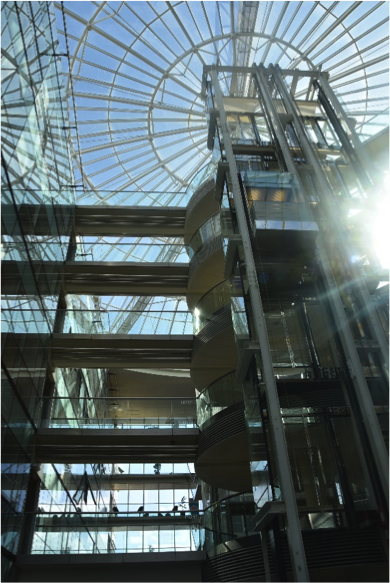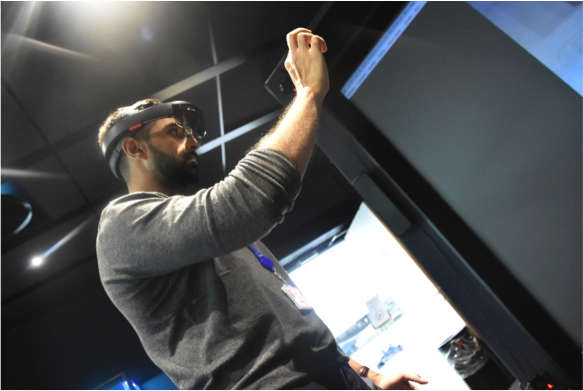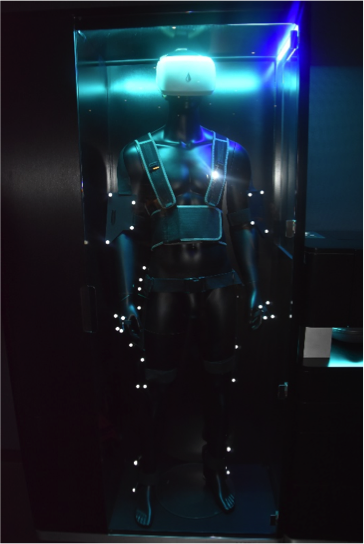When I was invited by HEC Paris’ Digital Transformation Club last November to join them for an exclusive visit to Alstom’s Headquarters, I wasn’t quite sure why a VR demo was on the itinerary. How could a global leader in the transportation sector possibly use virtual reality headsets? But even as we step inside Alstom’s Paris Headquarters – a towering glass building designed to replicate the inside of an engine – it’s clear to both myself and the 11 HEC Paris MBA students here today that this is a company dedicated to innovative technology.
“Living the product”
Once inside, we’re led to Alstom’s Virtual Reality Center (VRC) by Digital Innovation Director Carles Coca-Mascorda. His enthusiasm for explaining the products is infectious, but since the philosophy behind the technology is to “live the product”, it’s not long before we are handed VR headsets.
Instantly, we’re transported to the first class carriage of a train. I can walk up and down the aisles, choose a seat or even disembark the train to stand on the platform – all from the comfort of Alstom’s VRC (provided I take care not walk into any of the MBA students around me).
At first it’s fun to play around, switching between different upholstery fabrics and other materials in the train, but Carles shows us that it’s not just about the aesthetics. The technology takes us into the engine itself, to examine how everything fits together, and to practice changing faulty parts.
It’s clear that Carles sees this technology as more than just a novel way to show clients
what they’re buying. He predicts it will overhaul the entire production process, from design to manufacturing. “Normally a manufacturer will receive a plan that’s made up of a list of parts,” he says. “But what if they are able to see how all those parts fit together and interact all at once? With our 3D plans you can see the finished product straight away, and observe how every part fits together.
“For example, using written plans for a car, it takes a leap of imagination to conceptualize what it will be like to drive that car. You won’t get a sense of it ergonomically until you’ve made a mockup. You won’t realize that the steering wheel should be a little lower, or the buttons on the dashboard a little wider, until you’ve physically sat in that car. With VR, the moment you see the plans, you live the product.”
Aakarsh Srivastav, MBA ’21, is one of the students on today’s tour. A former aerospace design engineer, he explains that he used the same basic tools in his previous job, but not in the same way. “Being able to actually walk around and interact with designed parts in virtual reality, rather than just viewing them on a 2D computer screen, is mind-blowing. Trips like this are so insightful. They give MBAs a lot of perspective on how technology is evolving and changing the future of work.”
Digitalization vs. Digital Transformation
Carles believes that for true digital transformation to take place, we need to change the way we imagine products. “Our way of conceiving products is stuck in the past. In some countries, there is a legal requirement to deliver designs on paper, so that they can be stamped to confirm the product will last a minimum of 30-60 years,” he explains.
But, he adds, the answer is not simply to replace paper plans with screens. “That’s not digital transformation,” he insists, “that’s digitalization.” When a student asks to clarify this distinction, he explains: “I studied dinosaurs at school with a book. My children now do the same using a tablet. But the information we receive is exactly the same. A true digital transformation would be creating technology that allows you to live with the dinosaurs. The digital would transform not just the way you learn, but what you learn. And that’s what we’re doing with trains.”
This distinction between superficial and “true” digital transformation is something that Carles is keen to impress upon our group. Nikhil Nangia, President of the MBA Digital Transformation Club, agrees. “Digital transformation isn’t just a buzzword,” he says, explaining why the club’s Vice President, Dhruv Chhabra, decided to organize today’s visit. “It’s great to see firsthand how Alstom is leveraging AR, VR, Virtual Trains and Smart Engineering to pioneer the future.”



Recent Comments